Explore
the Adirondacks:
Nature Walk
19 July 2012
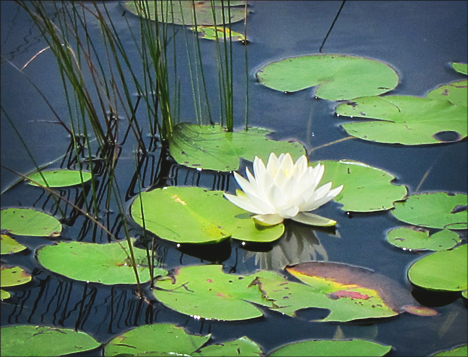



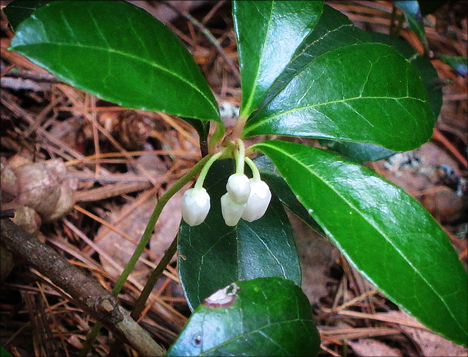
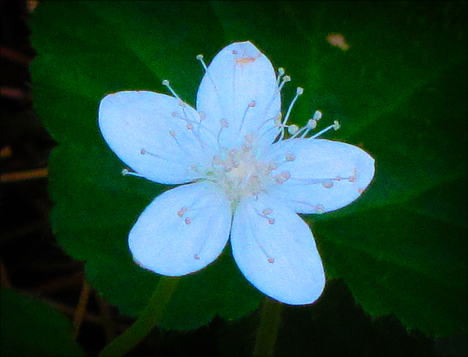




On 19 July, VIC naturalist Brian McAllister led a nature walk on the Heron Marsh Trail, exploring two different kinds of Adirondack habitats: mixed forest and marsh.
Mixed Forest
Our walk down the upper portions of the Heron Marsh Trail provided an opportunity to observe a mixed hardwood and conifer habitat. We examined three of the most common confers which grow in this habitat.
 Balsam Fir is a member of the pine family. It is well known for its fragrant
needles which are used for making balsam pillows. Balsam branches
were also used by Adirondack guides to line lean-tos, to make
a soft aromatic bed and to repel insects (thanks to the resins
in the tree). The needles of the Balsam Fir are flat and soft,
not spiky, and are shiny green above with two silvery lengthwise
lines on the underside. Balsam Fir is a popular Christmas tree,
because it holds its needles well after cutting.
Balsam Fir is a member of the pine family. It is well known for its fragrant
needles which are used for making balsam pillows. Balsam branches
were also used by Adirondack guides to line lean-tos, to make
a soft aromatic bed and to repel insects (thanks to the resins
in the tree). The needles of the Balsam Fir are flat and soft,
not spiky, and are shiny green above with two silvery lengthwise
lines on the underside. Balsam Fir is a popular Christmas tree,
because it holds its needles well after cutting.
Also growing on the upper portions of the Heron Marsh Trail are Eastern White Pine. These large conifers have much longer (three to five inch) soft needles, growing five per cluster. Each needle is flexible and triangular in cross section. The resin of the White Pine provides protection against insects. On the left side of the Heron Marsh Trail (about a five minute walk from the start of the trail) is a very large White Pine, estimated to be about 150 years old.
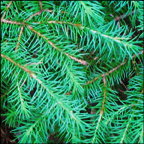 Red Spruce trees also grow along the Heron
Marsh Trail.
Another member of the pine family, this medium-sized tree has
a single straight trunk and stiff, pointed needles that appear
to be round, but actually are four-sided. The needles are positioned
all around the stem and (in contrast to the Balsam Fir) are prickly
and uncomfortable to grasp. Red Spruce is an extremely important
commercial tree species. The wood is strong and straight grained
and has been used to make lumber.
Red Spruce trees also grow along the Heron
Marsh Trail.
Another member of the pine family, this medium-sized tree has
a single straight trunk and stiff, pointed needles that appear
to be round, but actually are four-sided. The needles are positioned
all around the stem and (in contrast to the Balsam Fir) are prickly
and uncomfortable to grasp. Red Spruce is an extremely important
commercial tree species. The wood is strong and straight grained
and has been used to make lumber.
Hardwood trees along the Heron Marsh Trail include the Red Maple. This tree flourishes on the edge of a marshy habitat because it prefers wet to moist soils. The light green leaves of the Red Maple are three-lobed, with shallow notches in between the lobes and a double-toothed margin. The common name of the plant is derived from the red leaf stalks and also the fact that the tree turns red in fall. The sap of the Red Maple is less sugary than that of the Sugar Maple. The latter has five-lobed leaves and grows in rich moist soils in upland areas. It is a major source of maple sugar.
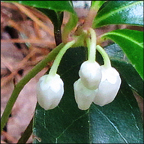 The
prevalence of pine trees in the upper portions of the Heron
Marsh Trail
create acidic soil, where acid-loving plants like blueberries
flourish. Wintergreen
grows in profusion along the Heron Marsh Trail. This low-growing
Adirondack wildflower has a waxy, evergreen leaf, which produces
a wintergreen flavor when chewed. The plant produces tiny, white
flowers, which bloom in July. These are followed by a red berry,
which is also edible and said to be loaded with Vitamin C. We
also observed Shinleaf,
Spreading
Dogbane, Indian Pipe, and Dewdrop in bloom, as well as Helleborine
Orchid (which was budding). Bunchberry
grows in profusion along the path; this plant (which is related
to dogwood) had bloomed earlier in the summer and was now producing
bright red fruit.
Canada
Mayflower also flourishes
here. Its white flowers had faded and the plant was producing
berries, which will eventually turn bright red. Like many plants,
these Adirondack wildflowers were about two to three weeks early,
due to the mild winter and warm temperatures in spring.
The
prevalence of pine trees in the upper portions of the Heron
Marsh Trail
create acidic soil, where acid-loving plants like blueberries
flourish. Wintergreen
grows in profusion along the Heron Marsh Trail. This low-growing
Adirondack wildflower has a waxy, evergreen leaf, which produces
a wintergreen flavor when chewed. The plant produces tiny, white
flowers, which bloom in July. These are followed by a red berry,
which is also edible and said to be loaded with Vitamin C. We
also observed Shinleaf,
Spreading
Dogbane, Indian Pipe, and Dewdrop in bloom, as well as Helleborine
Orchid (which was budding). Bunchberry
grows in profusion along the path; this plant (which is related
to dogwood) had bloomed earlier in the summer and was now producing
bright red fruit.
Canada
Mayflower also flourishes
here. Its white flowers had faded and the plant was producing
berries, which will eventually turn bright red. Like many plants,
these Adirondack wildflowers were about two to three weeks early,
due to the mild winter and warm temperatures in spring.
Marsh
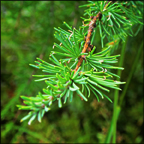 The
Heron
Marsh Trail has a series of viewing platforms and an
overlook which provide access to Heron Marsh. Plants which flourish
on the edge of the marsh
are related to rhododendrons and include Leatherleaf, Meadow Sweet, Steeplebush, and Sheep
Laurel. Tamaracks, also known as the Eastern Larch or American
Larch, also grow in the transition areas. Tamaracks are coniferous
tree, but -- in contrast to other conifers, which are evergreen
-- tamaracks shed their needles in the fall. In spring, the tree
produces new apple green needles, which gradually become darker
toward late spring.
The
Heron
Marsh Trail has a series of viewing platforms and an
overlook which provide access to Heron Marsh. Plants which flourish
on the edge of the marsh
are related to rhododendrons and include Leatherleaf, Meadow Sweet, Steeplebush, and Sheep
Laurel. Tamaracks, also known as the Eastern Larch or American
Larch, also grow in the transition areas. Tamaracks are coniferous
tree, but -- in contrast to other conifers, which are evergreen
-- tamaracks shed their needles in the fall. In spring, the tree
produces new apple green needles, which gradually become darker
toward late spring.
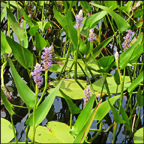 Heron
Marsh itself is one of several different types of Adirondack
wetlands on the VIC property. It is home to aquatic plants,
including the White
Water-lily and Pickerelweed.
The latter blooms in profusion in the shallower areas of the marsh.
Also blooming on the marsh are Yellow Pond Lilies. The North American River Otters who live on the marsh feed on fresh water mussels and clams. Heron Marsh is also
home to several families of beaver. There are two beaver lodges
on the marsh -- one on the northern side of the marsh (which can
be observed from the Barnum Brook Trail)
and another on the southern side (which can be observed from the Heron
Marsh Trail.)
Heron
Marsh itself is one of several different types of Adirondack
wetlands on the VIC property. It is home to aquatic plants,
including the White
Water-lily and Pickerelweed.
The latter blooms in profusion in the shallower areas of the marsh.
Also blooming on the marsh are Yellow Pond Lilies. The North American River Otters who live on the marsh feed on fresh water mussels and clams. Heron Marsh is also
home to several families of beaver. There are two beaver lodges
on the marsh -- one on the northern side of the marsh (which can
be observed from the Barnum Brook Trail)
and another on the southern side (which can be observed from the Heron
Marsh Trail.)
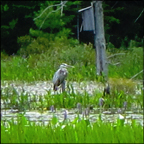 One
of the highlights of the walk was an excellent view of a Great
Blue Heron on the marsh. This majestic blue-gray bird is the
largest of the North American herons and can be seen standing
statue-like in the marsh, waiting for fish and other prey in the
shallow water. We also observed several Green Frogs and a Pickerel
Frog from the viewing platforms along the trail.
One
of the highlights of the walk was an excellent view of a Great
Blue Heron on the marsh. This majestic blue-gray bird is the
largest of the North American herons and can be seen standing
statue-like in the marsh, waiting for fish and other prey in the
shallow water. We also observed several Green Frogs and a Pickerel
Frog from the viewing platforms along the trail.
